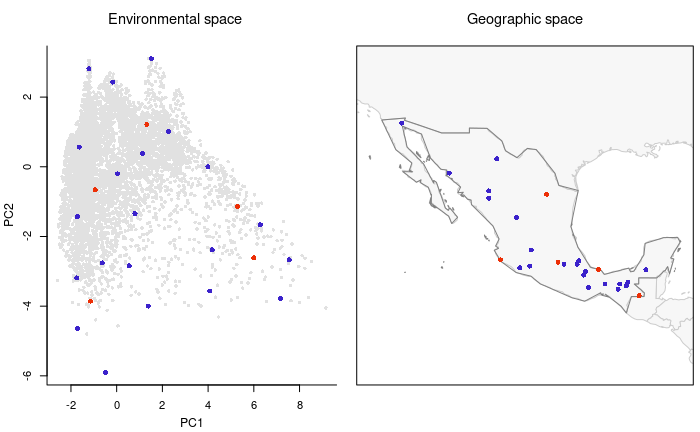biosurvey: Selecting sampling sites using preselected points
Claudia Nunez-Penichet, Marlon E. Cobos, Jorge Soberon, Tomer Gueta, Narayani Barve, Vijay Barve, Adolfo G. Navarro-Siguenza, A. Townsend Peterson, Weverton Trindade (ctb), Can Elverici (ctb)
Source:vignettes/biosurvey_selection_with_preselected_sites.Rmd
biosurvey_selection_with_preselected_sites.RmdData for analysis
Let’s first prepare the data to continue with further processes.
# Data
data("preselected", package = "biosurvey")
mx <- terra::vect(system.file("extdata/mx.gpkg", package = "biosurvey"))
variables <- terra::rast(system.file("extdata/variables.tif",
package = "biosurvey"))
# Create master matrix object
m_matrixp <- prepare_master_matrix(region = mx, variables = variables,
preselected_sites = preselected,
do_pca = TRUE, center = TRUE, scale = TRUE)
#> Processing raster layers, please wait...
#> Performing PCA analysis
summary(m_matrixp)
#>
#> Summary of a master_matrix object
#> ---------------------------------------------------------------------------
#>
#> Data matrix summary:
#> Longitude Latitude Mean_temperature Max_temperature
#> Min. :-118.25 Min. :14.58 Min. : 85.0 Min. :180.0
#> 1st Qu.:-107.08 1st Qu.:19.75 1st Qu.:175.0 1st Qu.:311.0
#> Median :-102.58 Median :24.25 Median :206.0 Median :335.0
#> Mean :-102.59 Mean :23.96 Mean :205.6 Mean :330.9
#> 3rd Qu.: -98.58 3rd Qu.:27.92 3rd Qu.:238.0 3rd Qu.:354.8
#> Max. : -86.75 Max. :32.58 Max. :291.0 Max. :425.0
#> Min_temperature Annual_precipitation Prec_wettest_month Prec_driest_month
#> Min. :-60.00 Min. : 44.0 Min. : 9.0 Min. : 0.00
#> 1st Qu.: 32.00 1st Qu.: 340.2 1st Qu.: 75.0 1st Qu.: 3.00
#> Median : 63.00 Median : 610.0 Median :143.0 Median : 5.00
#> Mean : 73.66 Mean : 764.2 Mean :163.4 Mean : 10.62
#> 3rd Qu.:117.00 3rd Qu.:1052.0 3rd Qu.:224.0 3rd Qu.: 12.00
#> Max. :214.00 Max. :4103.0 Max. :750.0 Max. :140.00
#> PC1 PC2
#> Min. :-2.554 Min. :-3.0597
#> 1st Qu.:-1.406 1st Qu.:-0.9560
#> Median :-0.601 Median :-0.1948
#> Mean : 0.000 Mean : 0.0000
#> 3rd Qu.: 1.109 3rd Qu.: 0.7920
#> Max. : 9.055 Max. : 5.9662
#>
#>
#> Region of interest:
#> class : SpatialPolygonsDataFrame
#> features : 1
#> extent : -118.4042, -86.7014, 14.55055, 32.71846 (xmin, xmax, ymin, ymax)
#> crs : +proj=longlat +datum=WGS84 +no_defs
#> variables : 11
#> names : FIPS, ISO2, ISO3, UN, NAME, AREA, POP2005, REGION, SUBREGION, LON, LAT
#> value : MX, MX, MEX, 484, Mexico, 190869, 104266392, 19, 13, -102.535, 23.951Exploring your data in environmental and geographic spaces
The data can be explored by creating four-panel plots using two environmental variables (at a time). The two top panels contain the information in geographic space (one predictor per panel). The two panels at the bottom contain information in a 2D environmental space for the two variables. This visualization can be done using the first two principal components that summarize most of the variance in your variables as shown below.
# Plot using Principal Components resulted
explore_data_EG(m_matrixp, variable_1 = "PC1", variable_2 = "PC2")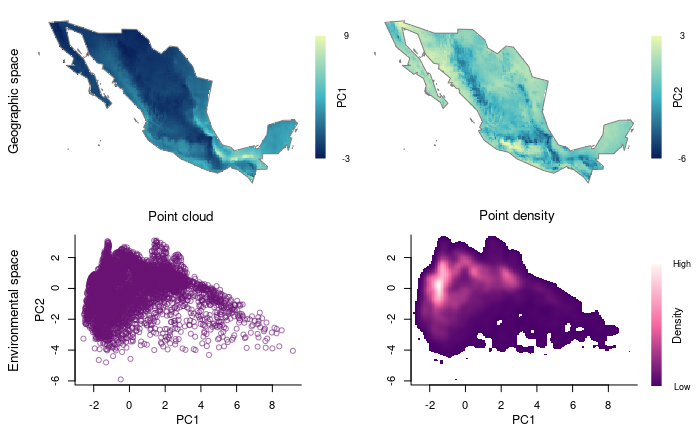
Partitioning environmental space to achieve uniformity in selections
Block-like partitioning of environmental space. Here, a two-dimensional cloud of points will be blocked according to a user-defined number of rows and columns. These will allow us to see the environmental space more uniformly.
# Creating blocks
m_blocks <- make_blocks(m_matrixp, variable_1 = "PC1",
variable_2 = "PC2", n_cols = 15, n_rows = 15,
block_type = "equal_area")Let’s check how the blocked environment looks like in environmental and geographic spaces.
# plotting all blocks
plot_blocks_EG(master = m_blocks, block_ID = TRUE)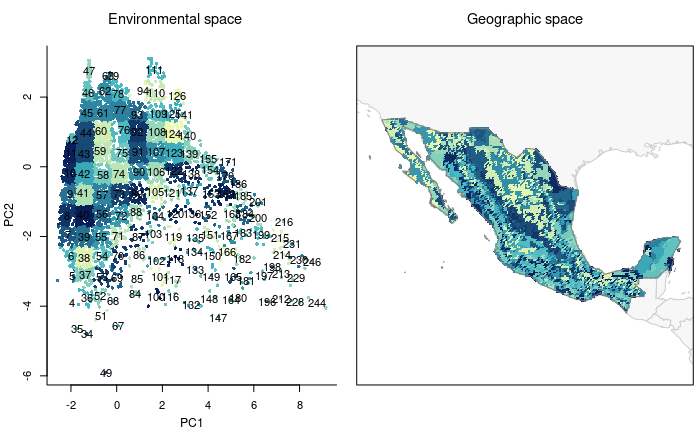
Selection of sampling sites based on distinct methods
The common goal of the following processes is to select sites to be sampled, but always including the preselected sites as part of the set of points selected.
Selection of sites considering environmental uniformity and geographic patterns
The goal of this type of selection is maximizing uniformity of points in environmental space, but considering geographic patterns of data. Similar environments (form the same block) that have a disjoint geographic pattern (are represented in geographic in various clusters) are selected twice (so they consider the biggest geographic clusters).
# Selecting sites uniformly in E and G spaces
EG_sel <- EG_selection(master = m_blocks, n_blocks = 20)
#> Preparing data for analysis
#> Running distance optimization, please wait...
#> Selecting relevant environmental blocks, please wait...
#> Running algorithm for selecting sites, please wait...
#> Process 1 of 10
#> Process 2 of 10
#> Process 3 of 10
#> Process 4 of 10
#> Process 5 of 10
#> Process 6 of 10
#> Process 7 of 10
#> Process 8 of 10
#> Process 9 of 10
#> Process 10 of 10
#> Total number of sites selected: 26
summary(EG_sel)
#>
#> Summary of a master_selection object
#> ---------------------------------------------------------------------------
#>
#> Sites preselected by user:
#> Site Longitude Latitude
#> 1 Chamela -105.04479 19.50090
#> 2 Los Tuxtlas -95.07419 18.58489
#> 3 Chajul -90.94067 16.17000
#> 4 Parque de Tlalpan -99.19778 19.29139
#> 5 Parque Chipinque -100.35940 25.61750
#>
#>
#> 2 columns and 6 rows of first elements are shown
#>
#> Sites selected randomly:
#> Empty
#>
#>
#> Sites selected uniformly in G space:
#> Empty
#>
#>
#> Sites selected uniformly in E space:
#> Empty
#>
#>
#> Sites selected uniformly in E space, considering G structure:
#> Longitude Latitude
#> 1 -105.04479 19.50090
#> 2 -95.07419 18.58489
#> 3 -90.94067 16.17000
#> 4 -99.19778 19.29139
#> 5 -100.35940 25.61750
#> 4477 -98.08333 20.41667Now let’s check the results of this selection in environmental and geographic spaces. In this and future plots of selected sites, user preselected sites will be plotted in red.
# Plotting sites selected uniformly in the geographic and in the environmental spaces
plot_sites_EG(EG_sel, selection_type = "EG")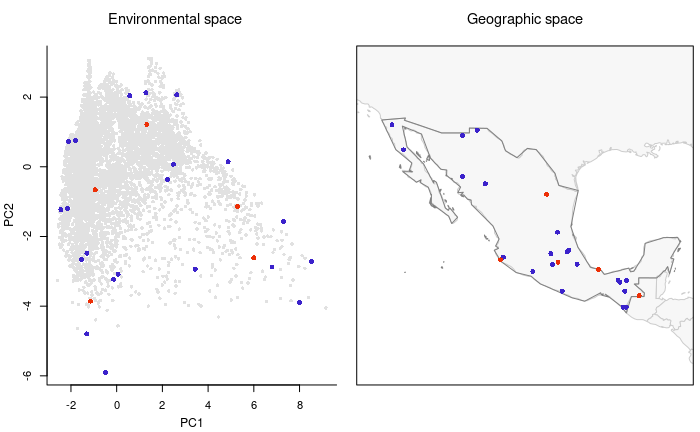
As you may have noticed, there are more points than what you defined
in the argument n_blocks in the function
EG_selection. This is because the function explores those
environmental blocks in geographic space and defines two points when the
geographic pattern of such points is clustered.
Selecting sites randomly
Selecting survey sites randomly is one of the multiple ways to select places to sample. Although it can be useful for avoiding some biases in the selection, it is not recommended when trying to sample most of the biodiversity in a region. The following lines of code will allow users to select survey sites based on a random selection of available points. This selection approach does not consider geographic or environmental configurations.
Note: We are going to use the object that resulted from the previous process of selection (a master_selection object) as it allows to add other sets of selected sites to maintain your results organized.
# Number of sites
nsites <- nrow(EG_sel$selected_sites_EG$selection_1)
# Selecting sites randomly
EG_r_selection <- random_selection(EG_sel, n_sites = nsites, n_samplings = 5)
#> Selecting sampling sites randomly
#> Total number of sites selected: 26
summary(EG_r_selection)
#>
#> Summary of a master_selection object
#> ---------------------------------------------------------------------------
#>
#> Sites preselected by user:
#> Site Longitude Latitude
#> 1 Chamela -105.04479 19.50090
#> 2 Los Tuxtlas -95.07419 18.58489
#> 3 Chajul -90.94067 16.17000
#> 4 Parque de Tlalpan -99.19778 19.29139
#> 5 Parque Chipinque -100.35940 25.61750
#>
#>
#> 2 columns and 6 rows of first elements are shown
#>
#> Sites selected randomly:
#> Longitude Latitude
#> 1 -105.04479 19.50090
#> 2 -95.07419 18.58489
#> 3 -90.94067 16.17000
#> 4 -99.19778 19.29139
#> 5 -100.35940 25.61750
#> 1017 -103.58333 29.08333
#>
#>
#> Sites selected uniformly in G space:
#> Empty
#>
#>
#> Sites selected uniformly in E space:
#> Empty
#>
#>
#> Sites selected uniformly in E space, considering G structure:
#> Longitude Latitude
#> 1 -105.04479 19.50090
#> 2 -95.07419 18.58489
#> 3 -90.94067 16.17000
#> 4 -99.19778 19.29139
#> 5 -100.35940 25.61750
#> 4477 -98.08333 20.41667Checking the sites selected randomly.
# Plotting randomly selected sites
plot_sites_EG(EG_r_selection, selection_type = "random", variable_1 = "PC1",
variable_2 = "PC2")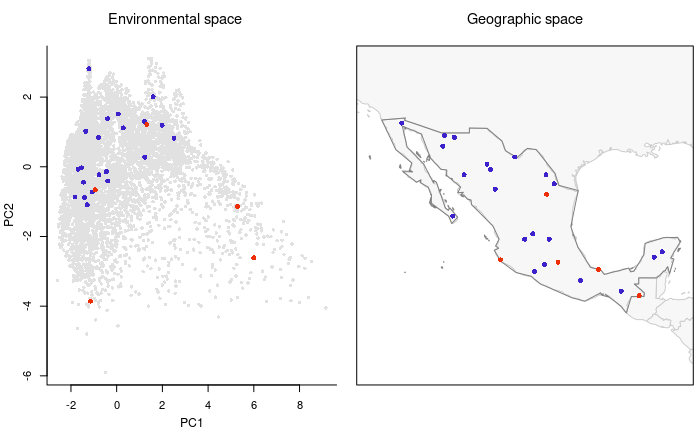
Selection of sites aiming for uniformity in geographic space
With the following lines of code, survey sites can be selected so they are located uniformly in geographic space, without considering environmental conditions. This allows sampling most of the areas in the region of interest.
# Selecting sites uniformly in G space
EG_r_G_selection <- uniformG_selection(EG_r_selection, expected_points = nsites)
#> Running distance optimization, please wait...
#> Running algorithm for selecting sites, please wait...
#> Distance 181.62 resulted in 30 points
#> Distance 199.782 resulted in 24 points
#> Distance 217.944 resulted in 23 points
#> Distance 236.106 resulted in 20 points
#> Distance 217.944 resulted in 23 points
#> Distance 219.7602 resulted in 22 points
#> Distance 221.5764 resulted in 22 points
#> Distance 223.3926 resulted in 22 points
#> Distance 225.2088 resulted in 22 points
#> Distance 227.025 resulted in 22 points
#> Distance 228.8412 resulted in 20 points
#> Distance 227.025 resulted in 22 points
#> Distance 227.20662 resulted in 22 points
#> Distance 227.38824 resulted in 21 points
#> Total number of sites selected: 26
summary(EG_r_G_selection)
#>
#> Summary of a master_selection object
#> ---------------------------------------------------------------------------
#>
#> Sites preselected by user:
#> Site Longitude Latitude
#> 1 Chamela -105.04479 19.50090
#> 2 Los Tuxtlas -95.07419 18.58489
#> 3 Chajul -90.94067 16.17000
#> 4 Parque de Tlalpan -99.19778 19.29139
#> 5 Parque Chipinque -100.35940 25.61750
#>
#>
#> 2 columns and 6 rows of first elements are shown
#>
#> Sites selected randomly:
#> Longitude Latitude
#> 1 -105.04479 19.50090
#> 2 -95.07419 18.58489
#> 3 -90.94067 16.17000
#> 4 -99.19778 19.29139
#> 5 -100.35940 25.61750
#> 1017 -103.58333 29.08333
#>
#>
#> Sites selected uniformly in G space:
#> Longitude Latitude
#> 1 -105.04479 19.50090
#> 2 -95.07419 18.58489
#> 3 -90.94067 16.17000
#> 4 -99.19778 19.29139
#> 5 -100.35940 25.61750
#> 1017 -103.58333 29.08333
#>
#>
#> Sites selected uniformly in E space:
#> Empty
#>
#>
#> Sites selected uniformly in E space, considering G structure:
#> Longitude Latitude
#> 1 -105.04479 19.50090
#> 2 -95.07419 18.58489
#> 3 -90.94067 16.17000
#> 4 -99.19778 19.29139
#> 5 -100.35940 25.61750
#> 4477 -98.08333 20.41667Let’s check the selected sites based only on geographic considerations.
# Plotting sites selected uniformly in the geographic space
plot_sites_EG(EG_r_G_selection, selection_type = "G", variable_1 = "PC1",
variable_2 = "PC2")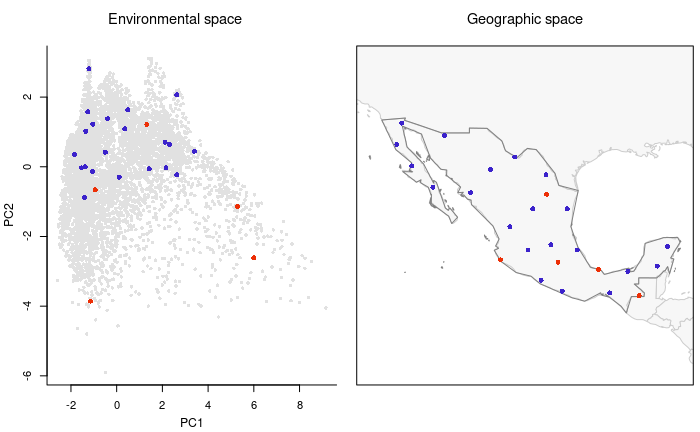
Selecting sites aiming for uniformity in environmental space
With the following lines of code you can select sampling sites that are uniformly distributed in environmental space. This will allow sampling most of the environmental conditions that are present in the region of interest.
# Selecting sites uniformly in E space
EG_r_G_E_selection <- uniformE_selection(EG_r_G_selection, expected_points = nsites)
#> Running distance optimization, please wait...
#> Running algorithm for selecting sites, please wait...
#> Distance 0.81 resulted in 35 points
#> Distance 0.891 resulted in 29 points
#> Distance 0.972 resulted in 27 points
#> Distance 1.053 resulted in 22 points
#> Distance 1.134 resulted in 20 points
#> Distance 1.053 resulted in 22 points
#> Distance 1.0611 resulted in 22 points
#> Distance 1.0692 resulted in 22 points
#> Distance 1.0773 resulted in 22 points
#> Distance 1.0854 resulted in 22 points
#> Distance 1.0935 resulted in 22 points
#> Distance 1.1016 resulted in 20 points
#> Distance 1.0935 resulted in 22 points
#> Distance 1.09431 resulted in 22 points
#> Distance 1.09512 resulted in 21 points
#> Total number of sites selected: 26
summary(EG_r_G_E_selection)
#>
#> Summary of a master_selection object
#> ---------------------------------------------------------------------------
#>
#> Sites preselected by user:
#> Site Longitude Latitude
#> 1 Chamela -105.04479 19.50090
#> 2 Los Tuxtlas -95.07419 18.58489
#> 3 Chajul -90.94067 16.17000
#> 4 Parque de Tlalpan -99.19778 19.29139
#> 5 Parque Chipinque -100.35940 25.61750
#>
#>
#> 2 columns and 6 rows of first elements are shown
#>
#> Sites selected randomly:
#> Longitude Latitude
#> 1 -105.04479 19.50090
#> 2 -95.07419 18.58489
#> 3 -90.94067 16.17000
#> 4 -99.19778 19.29139
#> 5 -100.35940 25.61750
#> 1017 -103.58333 29.08333
#>
#>
#> Sites selected uniformly in G space:
#> Longitude Latitude
#> 1 -105.04479 19.50090
#> 2 -95.07419 18.58489
#> 3 -90.94067 16.17000
#> 4 -99.19778 19.29139
#> 5 -100.35940 25.61750
#> 1017 -103.58333 29.08333
#>
#>
#> Sites selected uniformly in E space:
#> Longitude Latitude
#> 1 -105.04479 19.50090
#> 2 -95.07419 18.58489
#> 3 -90.94067 16.17000
#> 4 -99.19778 19.29139
#> 5 -100.35940 25.61750
#> 1081 -105.41667 28.91667
#>
#>
#> Sites selected uniformly in E space, considering G structure:
#> Longitude Latitude
#> 1 -105.04479 19.50090
#> 2 -95.07419 18.58489
#> 3 -90.94067 16.17000
#> 4 -99.19778 19.29139
#> 5 -100.35940 25.61750
#> 4477 -98.08333 20.41667Let’s check the selected sites based only on environmental considerations.
# Plotting sites selected uniformly in the environmental space
plot_sites_EG(EG_r_G_E_selection, selection_type = "E")